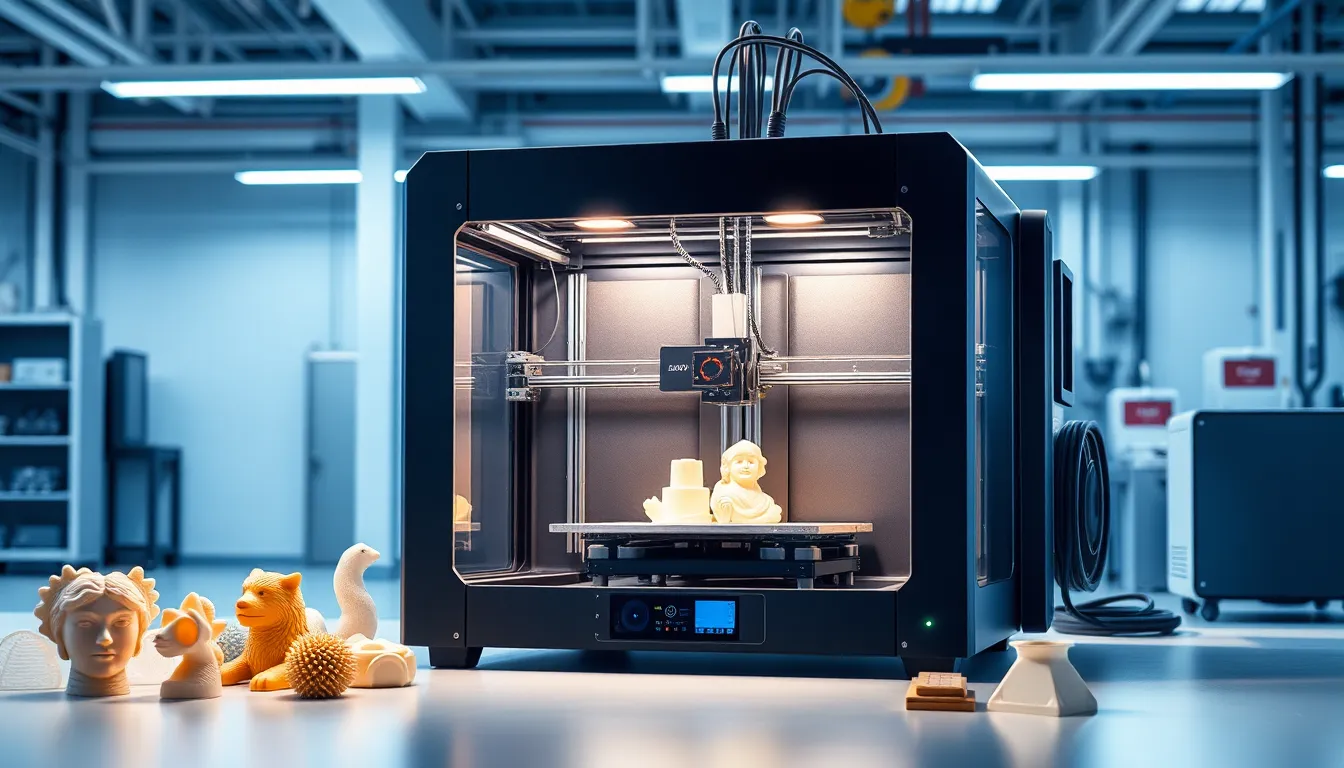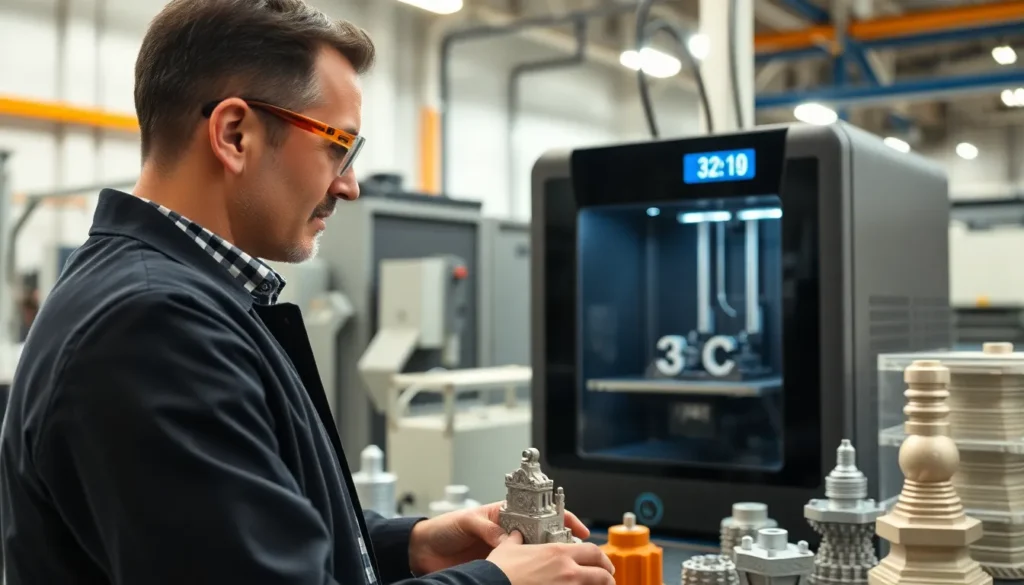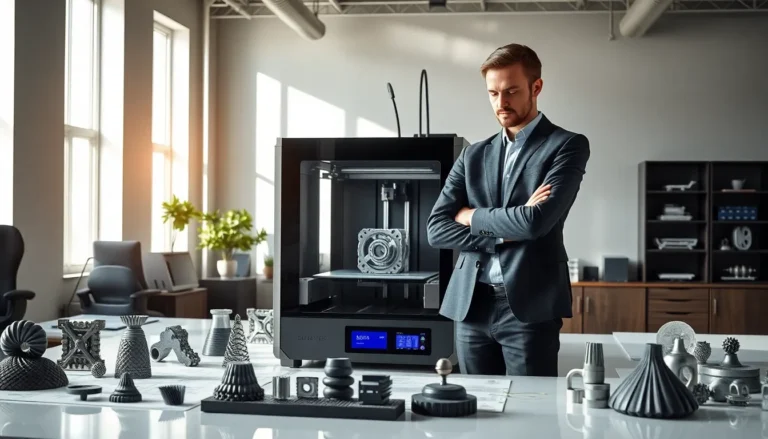Table of Contents
ToggleIn a world where waiting for your morning coffee feels like an eternity, high-speed 3D printers are here to change the game. Imagine cranking out intricate designs faster than you can say “additive manufacturing.” These marvels of technology don’t just print—they create, innovate, and transform ideas into reality at lightning speed.
Overview of High-Speed 3D Printers
High-speed 3D printers streamline the production process by leveraging advanced technologies that significantly increase printing speeds. Utilizing techniques such as Continuous Liquid Interface Production (CLIP) and Selective Laser Sintering (SLS), these printers can produce complex structures in a matter of hours rather than days.
In the realm of manufacturing, high-speed 3D printers support a diverse range of materials, including metals, plastics, and composites. They cater to multiple industries, such as aerospace, automotive, and healthcare, where precision and speed matter.
Printing resolutions, quality, and design flexibility improve with the latest models. These printers can deliver intricate patterns and fine details, maintaining durability and accuracy. The ability to produce custom parts quickly also enhances the prototyping phase, minimizing the time to market for new products.
Cost efficiency improves through reduced production times and the ability to use less material. Manufacturers can reduce waste and optimize resource utilization thanks to innovative technologies. Long-term investments in high-speed 3D printers often yield significant savings as businesses shift from traditional methods to additive manufacturing.
As industries evolve, the demand for rapid prototyping and on-demand production increases. High-speed 3D printers respond effectively to this trend, providing solutions that adapt to changing needs. Their impact on the manufacturing landscape is evident as they facilitate the transition from concept to reality, making them essential tools for modern production.
Key Technologies Behind High-Speed 3D Printing

High-speed 3D printing relies on several key technologies that enhance production speed and quality. Understanding these technologies reveals how modern manufacturing continues to evolve.
Stereolithography (SLA)
Stereolithography utilizes a laser to solidify liquid resin layer by layer. This technique fosters high precision and allows for intricate designs. It’s particularly effective for creating detailed prototypes in short time frames. SLA printers deliver smooth surface finishes, making them ideal for industries demanding high aesthetic standards. The ability to quickly produce complex geometries significantly affects product development timelines.
Digital Light Processing (DLP)
Digital Light Processing employs a digital light projector to cure resin, facilitating speedy layer solidification. Using an entire layer of resin at once dramatically decreases printing times compared to traditional methods. DLP technology supports a range of materials and offers fantastic resolution, essential for producing fine details. Its widespread adoption in sectors like jewelry and dentistry highlights its effectiveness in creating detailed models quickly.
Material Jetting
Material jetting functions similarly to inkjet printing, depositing droplets of material to form parts layer by layer. This technique enables the use of multiple materials simultaneously, allowing for color and material variation in a single print. Speed and versatility characterize material jetting, making it suitable for rapid prototyping and manufacturing complex assemblies. In industries such as aerospace and automotive, this technology satisfies needs for both precision and efficient production rates.
Benefits of High-Speed 3D Printers
High-speed 3D printers present numerous advantages that transform manufacturing processes. These benefits include increased productivity and enhanced cost efficiency.
Increased Productivity
High-speed 3D printers achieve remarkable production rates, allowing for quicker turnaround times. Printing speeds exceeding traditional methods streamline workflows. Rapid prototyping supports innovation, enabling teams to iterate designs swiftly. For instance, factories using Continuous Liquid Interface Production (CLIP) can produce parts in hours instead of days. Industries like aerospace and automotive heavily rely on this efficiency to meet tight deadlines. Moreover, it enables manufacturers to respond quickly to market demands. Increased automation in these printers also reduces labor-intensive tasks, allowing personnel to focus on more complex challenges.
Cost Efficiency
High-speed 3D printers contribute to significant cost savings through reduced material usage and shorter production times. Enhanced production speeds lead to lower operational costs, allowing more units to be produced within a given timeframe. Less waste during the printing process optimizes resources, which further decreases expenses. Industries can benefit from fewer material costs due to the precision of the printing processes. In addition, fewer production errors lead to reduced rework costs. Combined, these factors help manufacturers achieve a higher return on investment, making high-speed 3D printing an attractive option in competitive markets.
Applications of High-Speed 3D Printing
High-speed 3D printing showcases transformative potential across various industries, demonstrating versatility and efficiency.
Aerospace Industry
Aerospace applications leverage high-speed 3D printing to create lightweight components with complex geometries. Parts like brackets, ducts, and customized tooling benefit from reduced weight without compromising strength. Rapid prototyping expedites the development process, allowing engineers to test designs swiftly. Additionally, on-demand production minimizes inventory costs and supports just-in-time manufacturing practices. The shift to additive manufacturing in aerospace significantly reduces lead times and enhances operational efficiency, improving overall performance in aircraft design and production.
Medical Sector
In the medical sector, high-speed 3D printing enables the creation of patient-specific implants and prosthetics. Customization leads to improved fit, enhancing patient comfort and outcomes. Surgical planning benefits from 3D-printed models, allowing surgeons to rehearse complex procedures, which boosts confidence and precision. Furthermore, bioprinting technologies advance tissue engineering efforts by allowing for the creation of organ structures. The speed of these printers accelerates research and development, ultimately leading to innovative medical solutions that cater to individual patient needs.
Challenges and Limitations
High-speed 3D printers face several challenges that can impact their effectiveness. One significant limitation involves material constraints. Not all materials are suitable for high-speed printing, which restricts applications and necessitates ongoing research into novel materials.
Complex geometries can complicate the printing process. Although high-speed technology allows for intricate designs, precision and accuracy sometimes suffer, especially when working with specific shapes that require meticulous attention to detail. Quality control remains critical. Ensuring consistency across multiple printed parts can be difficult, leading to variations that may not meet industry standards.
Post-processing demands considerable attention and effort. Many high-speed prints require extensive finishing to achieve the desired surface quality. As a result, this adds time and labor costs to the production process. Equipment costs also pose a barrier. High-speed 3D printers require significant upfront investment, which might deter smaller companies from adopting the technology.
Another challenge lies in the learning curve associated with advanced 3D printing techniques. Employees must be trained in both the operation and maintenance of these machines, leading to increased time and resource allocation.
Intellectual property concerns frequently arise in the realm of 3D printing. The ability to easily replicate designs raises potential infringement issues, posing risks for companies that hold proprietary information. Lastly, the environmental impact of high-speed 3D printing deserves attention. While these technologies reduce waste compared to traditional manufacturing, the production and disposal of certain materials can still pose ecological challenges.
Navigating these hurdles requires continual innovation and collaboration across industries to maximize the benefits of high-speed 3D printing.
High-speed 3D printers are reshaping the manufacturing landscape by enabling rapid production and innovative design. Their ability to deliver intricate parts quickly is essential for industries demanding precision and efficiency. As technology advances, these printers continue to push the boundaries of what’s possible in prototyping and production.
While challenges remain in material limitations and quality control, the benefits far outweigh the drawbacks. Companies that embrace high-speed 3D printing can expect significant improvements in productivity and cost efficiency. The future of manufacturing is bright with these tools leading the charge toward a more agile and responsive industry.




